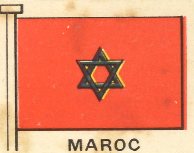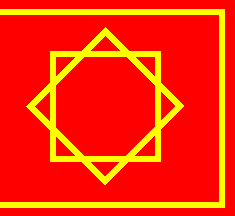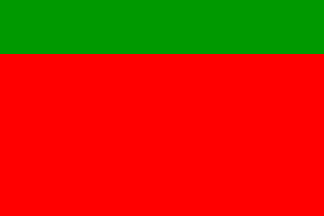|
|
Post by amksa on Jun 30, 2005 11:18:22 GMT -5
can someone explain me origin and meaning of this symbol on the former/first moroccan flag ?  |
|
|
|
Post by mike2 on Jun 30, 2005 11:21:17 GMT -5
That's not the flag for Morocco anymore?
|
|
|
|
Post by Melnorme on Jun 30, 2005 12:05:04 GMT -5
Well, I can guess why they changed it.
Of course, the five-sided star ( current flag ) is just as 'loaded' a symbol in certain circles.
|
|
|
|
Post by Crimson Guard on Jun 30, 2005 12:53:09 GMT -5
Yes its sorta become like the swastika symbol !
|
|
|
|
Post by shango on Jul 1, 2005 16:56:14 GMT -5
The Jews existed in North Africa for centuries back into before 1 B.C. Morocco has an ancient Jewish heritage and perhaps at some point most Berbers embraced Judaism. This is the first time I've seen the flag.
Todah Rabah
|
|
|
|
Post by iberomaurusian on Jul 1, 2005 17:22:25 GMT -5
The Jews existed in North Africa for centuries back into before 1 B.C. Morocco has an ancient Jewish heritage and perhaps at some point most Berbers embraced Judaism. This is the first time I've seen the flag. Todah Rabah   ; I'm tired of these religious americans! |
|
|
|
Post by iberomaurusian on Jul 1, 2005 17:27:59 GMT -5
Amksa; Battle flags with Marinid (Merinid) emblem (18-20 c.)
 1) During the “pacification” campaigns in the early XXth cent., French and Spanish troops captured war flags from Moroccan tribes; these were based on the Marinid emblem, a red field with two yellow interlaced squares forming a star.2) On 16 April 1908 on Menaba, Lieutenant-Colonel Perron captured a 2:3 flag based on the Marinid pattern, with a yellow crescent placed in each angle of the flag. On 6 September 1912, General Mangin captured in Sidi Bu Othman a similar flag, with a small crescent and full moon iside the Marinid emblem. Those two flags are kept in the Army Museum in Paris.Source: www.crwflags.com/fotw/flags/ma_hist.html |
|
|
|
Post by iberomaurusian on Jul 1, 2005 17:31:12 GMT -5
From the source above: (1)“Moor” flag as of 1848  (2) Modern Portuguese flag  Comments!? |
|
|
|
Post by Wadaad on Jul 1, 2005 17:41:37 GMT -5
I always wondered why Portugal shared the same flag colours with Morocco
|
|
|
|
Post by iberomaurusian on Jul 1, 2005 17:47:32 GMT -5
I think they picked the colors from the moors of Spain!  |
|
|
|
Post by amksa on Jul 2, 2005 5:30:36 GMT -5
thanks, Berter, for the infos. what i've read is that this symbol isn't exclusive to jews in morocco, this was use in magical and mystical purposes or something like that. 1868  1900  1879  1921  1945  1951  1953  i picked these picture from a very serious and "academical" amazigh website.  |
|
|
|
Post by Crimson Guard on Jul 2, 2005 9:47:41 GMT -5
Yes Pentagrams were used symbolically in ancient Greece and Babylonia. Same with hexagrams. very popular in the Ancient world.
|
|
|
|
Post by Tautalos on Jul 2, 2005 14:33:33 GMT -5
I think they picked the colors from the moors of Spain!  And the Lithuanians, picked the colours from the Moors of Spain as well?...   |
|
|
|
Post by Tautalos on Jul 2, 2005 14:35:51 GMT -5
In fact, the red and green Portuguese flag, is recent (1910) and comes from a masonic symbolism. The previous Portuguese flags, were all white and blue.
|
|
|
|
Post by duh on Jul 2, 2005 16:08:57 GMT -5
From the source above: (1)“Moor” flag as of 1848  (2) Modern Portuguese flag  Comments!? the moor flag's origins are unknown and it has nothing to do with Portugal.simply because they have some the colors ends right their. "moor" flag The book [noh71] shows as flag #251, captioned «Moors», a red flag, upper 1/4th green. Peter Hans van den Muijzenberg, 21 Jan 1999 -Portuguese flag Origin of the colours Those who trace the green and red from the 1385 flag or from the (red) Cross of Christ Order over green banner used during the 1640 revolution are wrong (including Crampton and Wh. Smith — oh well, even the Sun has its spots...). In fact the red and green found in the republican portuguese flag (in early flags usualy reversed, i.e., red near the hoist) were the colors of the iberian federalism (where they came from I do not know but I doubt it that the major influence was same old portuguese flags...), used since 1891 in Portugal by most “republican clubs” and by the Masonry, who replaced the previous blue and white flag in 1910. António Martins, 4 Jun 1997 The republican revolution of 1910 (and previous attempts and demonstrations) was largely inspired by a radical republican secret society called Carbonária (akin to the Masonry), inspired in an older italian organization of the same name. These called themselves the charcoal-makers (carbonari), who were free to go out of town to the forests get their wood... and conspire at will away from the landlord’s spys — hence the alias The Forest Masons (Maçonaria Florestal). Being Saint John the patron of charcoal-makers, red and green was also theyer color, both of genuine charcoal-makers guild and of the later secret society, and later the color of portuguese radical republicans... (Other interpretations of the 1910 colors, even the contemporary, official ones, are pure fantasy and wishful thinking — or sand in the eyes of an after all quite conservative, non-radical people...) António Martins, 19 Feb 1998 I didn’t know the Carbonari existed outside of Italy. The Carbonari flag was horizontal stripes of blue (top), red and black, representing the burning charcoal. Dave Martucci, 22 Feb 1998 Portuguese Carbonarians (namely Associação 31 de Janeiro, in Oporto) used a red flag with a green circle and some lettering. I was told these are based on (charcoal maker’s patron) St. John. António Martins, 3 Mar 1998 |
|